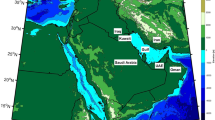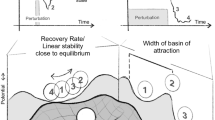Abstract
Two concepts are introduced for detecting abrupt climate changes. In the first case, the sampling frequency of climate data is high as compared to the frequency of climate events examined. The method is based on a separation of trend and noise in the data and is applicable to any dataset that satisfies some mild smoothness and statistical dependence conditions for the trend and the noise, respectively. We say that an abrupt change occurs when the first derivative of the trend function has a discontinuity and the task is to identify such points. The technique is applied to Northern Hemisphere temperature data from 1850 to 2009, Northern Hemisphere temperature data from proxy data, a.d. 200–1995 and Holocene δ18O values going back to 11,700 years BP. Several abrupt changes are detected that are, among other things, beneficial for determining the Medieval Warm Period, Little Ice Age and Holocene Climate Optimum. In the second case, the sampling frequency is low relative to the frequency of climate events studied. A typical example includes Dansgaard–Oeschger events. The methodology used here is based on a refinement of autoregressive conditional heteroscedastic models. The key element of this approach is the volatility that characterises the time-varying variance, and abrupt changes are defined by high volatilities. The technique applied to δ18O values going back to 122,950 years BP is suitable for identifying DO events. These two approaches for the two cases are closely related despite the fact that at first glance, they seem quite different.






Similar content being viewed by others
References
Alley RB, Mayewski PA, Sowers T, Stuvier M, Taylor KC, Clark PU (1997) Holocene Climate instability: a prominent widespread event 8200 year ago. Geology 25:483–486
Amano T, Taniguchi M (2008) Asymptotic efficiency of conditional least squares estimators for ARCH models. Stat Probab Lett 78:179–185
Baldini JUL, McDermott F, Fairchild IJ (2002) Structure of the 8200-year cold event revealed by a speleothem trace element record. Science 296:2203–2206
Bollerslev T (1986) Generalized conditional heteroscatisticity. J Econom 31:307–327
Bradley RS, Hughes MK, Diaz HF (2003) Climate in medieval time. Science 302:404–405
Braun H (2009) Strong indications for nonlinear dynamics during Dansgaard-Oeschger events. Clim Past Discuss 5:1751–1762
Braun H (2010) Limitations of red noise in analysing Dansgaard-Oeschger events. Clim Past 6:85–92
Braun H, Christl M, Rahmstorf S, Ganopolski A, Mangini A, Kubatzki C, Roth K, Kromer B (2005) Possible solar origin of the 1, 470-year glacial climate cycle demonstrated in a coupled model. Nature 438:208–211
Braun H, Ditlevsen P, Chialvo DR (2008) Solar forced Dansgaard-Oeschger events and their phase relation with solar proxies. Geophys Res Lett 35:L06703
Cheng H, Fleitmann D, Edwards LR, Wang X, Cruz FW, Auler AS, Mangini A, Wang Y, Kong X, Burns SJ, Matter A (2009) Timing and structure of the 8.2 kyr B.P. event inferred from 18O records of stalagmites from China, Oman, and Brazil. Geology 37:1007–1010
Cline DBH, Eubank RL, Speckman PL (1995) Nonparametric estimation of regression curves with discontinuous derivatives. J Stat Res 29:17–30
Dakos V, Scheffer M, van Nes EH, Brovkin V, Petoukhov V, Held H (2008) Slowing down as an early warning signal for abrupt climate change. Proc Natl Acad Sci USA 105:14308–14312
Ditlevsen PD, Ditlevsen OV (2009) On the stochastic nature of the rapid climate shifts during the last ice age. J Climate 22:446–457
Ditlevsen PD, Kristensen MS, Andersen KK (2005) The recurrence time of Dansgaard-Oeschger events and limits on the possible periodic cimponent. J Climate 18:2594–2603
Engle R (1982) Autoregressive conditional heteroscedasticity with estimation of United Kingdom inflation. Econometrics 50:987–1008
Fan J (1992) Design-adaptive nonparametric regression. J Am Stat Assoc 87:998–1004
Fan J (1993) Local linear regression smoothers and their ninimax efficiency. Ann Math Stat 21:196–216
Fan J, Gijbels I (1992) Variable bandwidth and local linear regression smoothers. Ann Math Stat 20:2008–2036
Fan J, Yao Q (2005) Nonlinear time series: nonparametric and parametric methods. Springer, New York
Feng G, Gong Z, Zhi R (2010) Latest advances in climate change detection techniques. Acta Meteorol Sin 24:1–16
Francisco-Fernandez M, Vilar-Fernandez J (2004) Weighted local nonparametric regression with dependent errors: study of real private residential fixed investment in the USA. Stat Inference Stoch Process 7:69–93
Fletcher WJ, Sanchez Goñi MF, Peyron O, Dormoy I (2010) Abrupt climate changes of the last deglaciation detected in a Western Mediterranean forest record. Clim Past 6:245–264
Fliess M, Join C, Mboup M (2010) Algebraic change-point detection. Appl Algebra Eng Commun Comput 21:131–143
Fraedrich K, Jiang J, Gerstengarbe F-W, Werner PC (1997) Multiscale detection of abrupt climate changes: application to River Nile flood levels. Int J Climatol 17:1301–1315
Francq C, Zakoian J-M (2004) Maximum likelihood estimation of pure GARCH and ARMA-GARCH processes. Bernoulli 10:605–637
Fryzlewicz P, Sapatinas T, Rao SS (2008) Normalized least-squaresestimation in time-varying ARCH models. Ann Math Stat 36:742–786
Gijbels I, Goderniaux AC (2004) Bootstrap test for change-points in nonparametric regression. J Nonparametr Stat 16:591–611
Glosten LR, Jagannathan R, Runkle DE (1993) On the Relation between the expected value and the volatility of the nominal excess returns on stocks. J Finance 48:1779–1801
Grove JM (1988) The little ice age. Methuen, New York
He WP, Feng GL, Wu Q, Wan SQ, Chou JF (2008) A new method for abrupt change detection in dynamic structures. Nonlinear Process Geophys 15:601–606
Hughes AW, King ML, Kwek KT (2004) Selecting the order of an ARCH model. Econ Lett 83:269–275
Ivanov MA, Evtimov SN (2010) 1963: The break point of the Northern Hemisphere temperature during the twentieth century. Int J Climatol 30:1738–1746
Jiang J, Mendelssohn R, Schwing F, Fraedrich K (2002) Coherency detection of multiscale abrupt changes in historic Nile flood levels. Geophys Res Lett 29:1271. doi:10.1029/2002GL014826
Johnsen SJ, Dahl-Jensen D, Gundestrup N, Steffensen JP, Clausen HB, Miller H, Masson-Delmotte V, Sveinbjörnsdottir AE, White J (2001) Oxygen isotope and palaeotemperature records from six Greenland ice-core stations: Camp Century, Dye-3, GRIP, GISP2, Renland and NorthGRIP. J Quat Sci 16:299–307
Jones PD, Mann ME (2004) Climate over past millennia. Rev Geophys 42(2):RG2002. doi:10.1029/2003RG000143
Jones PD, Parker DE, Osborn TJ, Briffa KR (2010) Global and hemispheric temperature anomalies—land and marine instrumental records. In Trends: a compendium of data on global change. Carbon Dioxide Information Analysis Center, Oak Ridge National Laboratory, U.S. Department of Energy, Oak Ridge, Tenn., U.S.A. doi: 10.3334/CDIAC/cli.002
Kaufman DS, Ager TA, Anderson NJ, Anderson PM, Andrews JT, Bartlein PJ, Brubaker LB, Coats LL, Cwynar LC, Duvall ML, Dyke AS, Edwards ME, Eisner WR, Gajewski K, Geirsdottir A, Hu FS, Jennings AE, Kaplan MR, Kerwin MW, Lozhkin AV, MacDonald GM, Miller GH, Mock CJ, Oswald WW, Otto-Bliesner BL, Porinchu DF, Ruhland K, Smol JP, Steig EJ, Wolfe BB (2004) Holocene thermal maximum in the western Arctic (0–180°W). Quat Sci Rev 23:529–560
Kendall RA, Mitrovica JX, Milne GA, Törnqvist TE, Li Y (2008) The sea-level fingerprint of the 8.2 ka climate event. Geology 36:423–426
Kobashi T, Severinghaus JP, Brook EJ, Barnola JM, Grachev AM (2007) Precise timing and characterization of abrupt climate change 8200 years ago from air trapped in polar ice. Quat Sci Rev 26:1212–1222
Lamb HH (1977) Climate history and the future, vol. 2, climate: present, past and future. Methuen, New York
Lenton TM, Held H, Kriegler E, Hall JW, Lucht W, Rahmsdorf S, Schellnhuber HJ (2008) Tipping elements in the Earth’s climate system. Proc Natl Acad Sci USA 105:1786–1793
Li C, Battisti DS, Bitz CM (2010) Can North Atlantic sea ice anomalies account for Dansgaard-Oeschger climate signals? J Climate. doi:10.1175/2010JCLI3409.1
Liew VK-S, Chong T-L (2005) Autoregressive Lag Length Selection Criteria in the Presence of ARCH errors. Econ Bull 3:1–5
Lutz B, Wiles G, Lowell T, Michaels J (2007) The 8.2-ka abrupt climate change event in Brown’s Lake, Northeast Ohio. Quat Res 67:292–296
Marshall SJ, Koutnik MR (2006) Ice sheet action versus reaction: distinguishing between Heinrich events and Dansgaard-Oeschger cycles in the North Atlantic. Paleoceanography 21(PA2021):13. doi:10.1029/2005PA001247
Massé G, Rowland SJ, Sicre M-A, Jacob J, Jansen E, Belt ST (2008) Abrupt climate changes for Iceland during the last millennium: evidence from high resolution sea ice reconstructions. Earth Planet Sci Lett 269:565–569
Matyasovszky I (2010) Trends, time-dependent and nonlinear time series models for NGRIP and VOSTOK paleoclimate data. Theor Appl Climatol 101:433–443
Mayewski PA, Rohling EE, Stager C, Karlén W, Maasch KA, Meeker LD, Meyerson EA, Gasse F, van Kreveld S, Holmgren K, Lee-Thorp J, Rosqvist G, Rack F, Staubwasser M, Schneider RR, Steig EJ (2004) Holocene climate variability. Quat Res 62:243–255
Mousazadeh S, Karimi M, Farrokhrooz M (2007) ARCH parameter estimation via constrained two-stage least squares method. Signal Processing and Application 2007, ISSPA 2007, 9th International Symposium 12–15 Feb. 2007, pp 1–4
Mudelsee M (2000) Ramp function regression: a tool for quantifying climate transitions. Comput Geosci 26:293–307
Müller HG, Song KS (1997) Two-stage change-point estimators in smooth regression models. Stat Probab Lett 34:323–335
National Research Council (2002) Abrupt climate change: inevitable surprises. National Academy Press, Washigton, DC
North Greenland Ice Core Project members (2004) North Greenland ice core project oxygen isotope data. IGBP PAGES/World Data Center for Paleoclimatology Data Contribution Series # 2004-059. NOAA/NGDC Paleoclimatology Program, Boulder CO, USA. Contributor: Sigfús J. Johnsen, University of Copenhagen
Qiu P, Yandell B (1988) A local polynomial jump detection algorithm in nonparametric regression. Technometrics 40:142–152
Rahmstorf S (2003) Timing of abrupt climate change: a precise clock. Geophys Res Lett 30:1510. doi:1029/2003GL017115
Rahmstorf S (2002) Ocean circulation and climate during the past 120, 000 years. Nature 419:207–214
Rasmussen SO, Andersen KK, Svensson AM, Steffensen JP, Vinther BM, Clausen HB, Siggaard-Andersen M-L, Johnsen SJ, Larsen LB, Dahl-Jensen D, Bigler M, Röthlisberger R, Fischer H, Goto-Azuma K, Hansson ME, Ruth U (2006) A new Greenland ice core chronology for the last glacial termination. J Geophys Res 111:D06102. doi:10.1029/2005JD006079
Schmidt MW, Vautravers MJ, Spero HJ (2006) Rapid subtropical North Atlantic salinity oscillations across Dansgaard–Oeschger cycles. Nature 443:561–564
Smadi MM (2006) Observed abrupt changes in minimum and maximum temperatures in Jordan in the 20th century. Amer J Environ Sci 2:114–120
Szentimrey T, Farago T, Szalai S (1992) Window technique for climate trend analysis. Clim Dyn 6:127–134
Thomas ER, Wolf EW, Mulvaney R, Steffensen JP, Johnsen SI, Arrowsmith C, White JWC, Vaughn B, Popp T (2007) The 8.2 ka event from Greenland ice cores. Quat Sci Rev 26:70–81
Thompson DWJ, Wallace JM, Kennedy JJ, Jones PD (2010) An abrupt drop in Northern Hemisphere sea surface temperature around 1970. Nature 467:444–447
Timmermann A, Gildor H, Schultz M, Tziperman E (2003) Coherent resonant millennial-scale climate oscillations triggered by glacial meltwater pulses. J Climate 16:2569–2585
Tong H (1990) Non-linear time series. Calderon, Oxford
Vinther BM, Clausen HB, Johnsen SJ, Rasmussen SO, Andersen KK, Buchardt SL, Dahl-Jensen D, Seierstad IK, Siggaard-Andersen M-L, Steffensen JP, Svensson AM, Olsen J, Heinemeier J (2006) A synchronized dating of three Greenland ice cores throughout the Holocene. J Geophys Res 111:D13102. doi:10.1029/2005JD006921
Wishart J (2009) Kink estimation with correlated noise. J Korean Stat Soc 38:131–143
Zhao F, Xu Z, Huang J (2007) Long-term trend and abrupt change for major climate variables in the upper yellow river basin. Acta Meteorol Sin 21:204–214
Acknowledgements
The European Union and the European Social Fund provided financial support for the project under the grant agreement no. TÁMOP 4.2.1./B-09/KMR-2010-0003.
Author information
Authors and Affiliations
Corresponding author
Rights and permissions
About this article
Cite this article
Matyasovszky, I. Detecting abrupt climate changes on different time scales. Theor Appl Climatol 105, 445–454 (2011). https://doi.org/10.1007/s00704-011-0401-4
Received:
Accepted:
Published:
Issue Date:
DOI: https://doi.org/10.1007/s00704-011-0401-4




